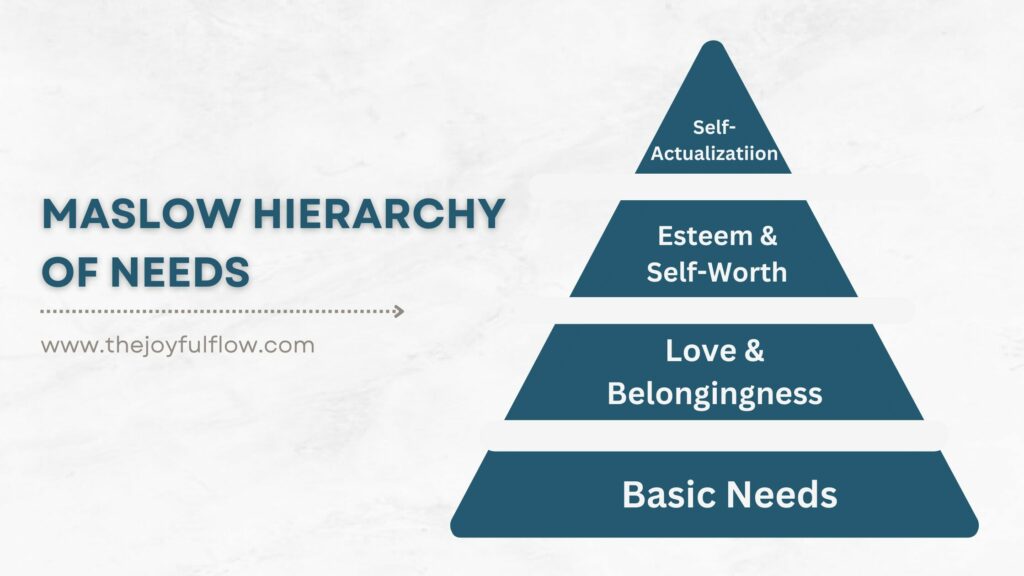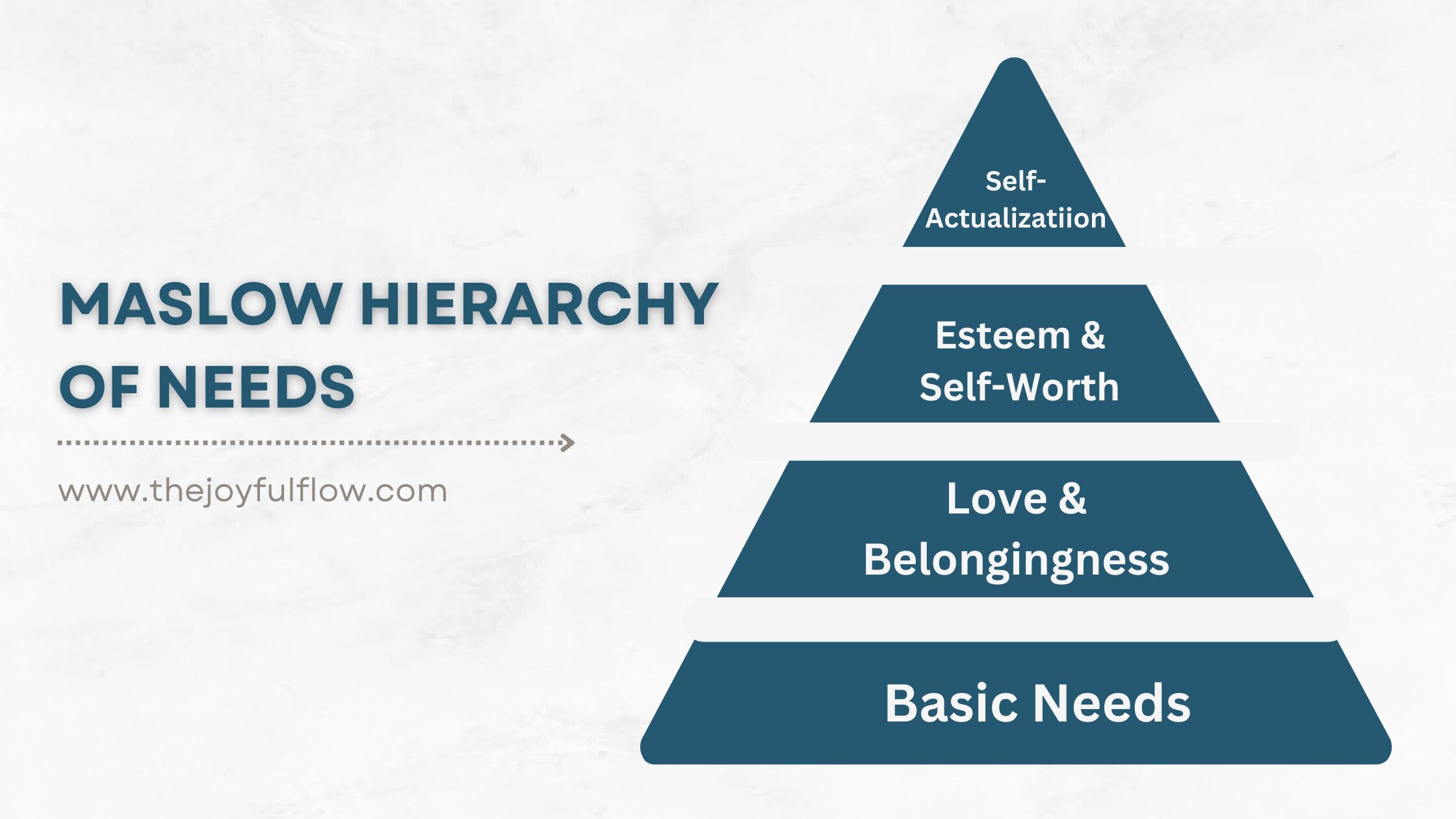The Maslow’s hierarchy of needs is a model created by the psychologist Abraham Maslow in 1950. This theory represents a hierarchy of the human needs. Maslow believed people can find motivation to satisfy specific human needs, starting with basic human needs, such as food and shelter. Once the most basic needs are fulfilled, people will look to satisfy needs of a higher level. For example, someone hungry will gravitate to find food first instead of looking for friends or recognition. Here is a guide to understanding human motivation at a deeper level.
- Physiological needs: food, water, sleep
- Safety needs: protection, stability, home
- Love and Belongingness: affection, friendship, relationships
- Self-Esteem and Self-Worth: recognition, status.
- Self-Actualization: self-realization, growth, self-improvement.

1. Physiological Needs
Physiological needs refer to the basic physical requirements needed for human survival. These include food, water, shelter, sleep, and other bodily necessities. According to Maslow’s hierarchy of needs, physiological needs are the most fundamental to meet before an individual solves higher-level needs.
- Food: provides the calories and nutrients required to maintain bodily functions and health. Having consistent access to nutritious, satisfying food is essential for well-being. Food insecurity has serious detrimental effects on physical and mental health.
- Water makes up the majority of the human body. Water helps regulate body temperature, lubricates joints, protects organs and tissues, and more. Dehydration rapidly causes organs to fail, so consistent clean water intake is a basic physiological necessity.
- Shelter refers to adequate housing that protects from the elements and provides safety and space for rest. Without stable shelter, individuals suffer a greater risk of injury and health problems. Access to shelter is a prerequisite for physical and mental recovery.
- Rest: gives the body and mind time to recharge. Humans require regular sleep to allow the brain to repair itself and solidify memories. Insufficient rest impairs cognition, emotional state, and immunity. Adequate rest helps sustain essential physiological functioning.
Satisfying these fundamental physiological needs lays the groundwork for fulfilling higher-level needs. Once food, water, shelter, and rest are secured, individuals can then focus energy on other human wants and self-actualization. However, physiological needs remain an ongoing requirement throughout life.
2. Safety Needs
Safety needs encompass our need for security, stability, and freedom from fear. These needs motivate us to seek order, structure, limits, and stability. Safety needs include:
- Physical safety and security refer to freedom from harm, assault, war, crime, and the threat of physical violence. People seek to live in safe areas, have food and shelter security, and protect themselves from animals and environmental threats.
- Financial and economic security: The need for steady employment, income, savings, insurance, and freedom from extreme poverty that threatens survival. Financial stability provides a safety net in case of job loss or economic hardship.
- Health and well-being security: Access to quality healthcare, clean water, nutrition, exercise, rest, and a healthy work-life balance. This provides freedom from accidents, disease, and mental illness that can disrupt a stable life.
- Social stability refers to stable social order, lawfulness, lack of chaos, and anarchy in society. People need predictability in social interactions and behavioral norms to be consistent daily.
To achieve safety needs, individuals seek healthy relationships, insurance policies, nest eggs, medical coverage, safe neighborhoods and homes, routines, structure, order, and lawfulness in society. Safety needs motivate us to prefer predictability and avoid uncertainty. When these needs are unmet, people experience high anxiety, stress, fear, and trauma. Meeting safety needs is key to creating a stable foundation for pursuing other needs.
3. Love and Belongingness
Humans are intrinsically social creatures with an innate need to belong. Developing strong interpersonal relationships and connections with others is a key component of the belongingness needs in Maslow’s hierarchy. This includes relationships with family, friends, romantic partners, and the broader community.
Having a sense of belonging provides several benefits:
- Emotional support and care from others
- Shared experiences, memories, and bonding
- Feeling valued, accepted, included
- Collaboration, teamwork, and synergy of groups
- Expanded social networks and access to resources
- Sense of identity and self-worth from group associations
To satisfy the need to belong, one must remove barriers to strong relationships, such as insecurity, shyness, and emotional walls. This requires vulnerability, openness to intimacy, active listening, and quality time together. Shared values, empathy, and compromise also strengthen social bonds.
Individuals should surround themselves with positive people who support growth and accept them for who they are. Joining groups and communities centered around shared interests and passions can facilitate new connections. Contributing meaningfully to one’s social circles creates feelings of worthiness and acceptance.
Developing close family ties provides a strong foundation. Marriages and parenting can add deeper purpose and generativity. Strong friendships bring fun, security, and emotional nourishment. Feeling part of a broader community, whether a workplace, religious group or volunteer organization, also fulfills the human need for belongingness.
4. Self-Esteem & Worth
Esteem needs to relate to feeling respected and valued. This includes self-esteem (confidence, achievement, respect of self) and esteem from others (status, recognition, attention).
Esteem represents the normal human desire to be accepted and valued by others. People often seek prestige and status as a sign of success and achievement. Recognition, social status, and attention help fulfill esteem needs.
Some ways to achieve esteem needs:
- Set and accomplish meaningful goals. Feeling productive and having real achievements raises self-esteem.
- Gain skills and expertise. Mastery of skills leads to confidence and higher self-regard.
- Take on challenging tasks. Overcoming difficulty through effort builds self-respect.
- Receive praise and positive feedback. Compliments from others satisfy our esteem needs.
- Earn awards and honors. External validation and recognition from others boost self-worth.
- Gain positions of responsibility. Higher status and leadership roles provide esteem.
- Dress stylishly. Attractive, elegant clothing commands respect and admiration.
- Display accomplishments publicly. Diplomas, trophies, and certificates signify success.
- Share your success on social media. Post updates highlighting achievements and milestones.
- Give presentations and speeches. Communicating ideas effectively builds confidence.
- Volunteer and donate to charity. Contributing to causes brings respect and acclaim.
Satisfying esteem needs leads to feelings of self-worth, capability, usefulness, and adequacy. This inner feeling of competence and social worth promotes continued success and achievement.
5. Self-Actualization
Self-actualization refers to the highest level of psychological development in Maslow’s hierarchy of needs. At this stage, individuals strive to achieve their full potential and realize their higher purpose in life.
According to Maslow, only a small percentage of the population ever reaches self-actualization. This is because basic and psychological needs must be met before focusing on growth. However, self-actualization is an ongoing process rather than a final destination. Those seeking self-actualization must be open to continual learning and challenges.
To achieve self-actualization, it is important to:
- Find your passion and purpose. Identify activities and roles that provide meaning.
- Challenge yourself continuously to learn, improve, and actualize your potential.
- Reflect on your values and life vision. Ensure your goals align with your higher purpose.
- Appreciate the journey, not just the destination. Revel in the process of growth.
- Develop your creativity. Nurture your imagination through art, music, writing, etc.
- Connect with others deeply. Foster intimacy and compassion in relationships.
- Immerse yourself fully in experiences. Practice mindfulness and presence.
- Give back to others through service, mentoring, or contributions.
The path to self-actualization is deeply personal and unique to each individual. But committing to knowing oneself fully and striving to become all one can lead to immense fulfillment and achievement. For those willing to explore the heights of human potential, self-actualization offers endless growth opportunities.
Achieving Success
Maslow’s hierarchy of needs provides a useful framework for considering human motivation and goals. Each level of the pyramid represents a fundamental human need that must be met before proceeding to pursue higher needs. Applying Maslow’s hierarchy can help you set realistic goals to address your deficiencies.
- Start with the bottom level of physiological needs and ensure you have adequate survival essentials. Once those needs are met, focus on improving safety and security in your life. Consider your health, employment, finances, living situation, and relationships. Ask yourself if you feel protected from harm.
- When your basic needs are met, strive for love and belonging. Make meaningful connections with others through friendship, family, and romantic partnerships. Join groups aligned with your interests or values. Support and be supported by your community.
- As you become confident in your social bonds, seek opportunities to gain self-esteem and achievement. Take on challenges that play to your strengths. Set goals that are authentic to your talents and desires. Receive praise and recognition from those who matter to you. Remind yourself of past successes and areas for growth.
- Once you feel loved and valued by others, find ways to satisfy your self-actualization needs through knowledge, meaning, and self-awareness. Never stop learning and expanding your mind. Question your assumptions and seek deeper truths. Determine your personal values, passions, and purpose.
By applying Maslow’s hierarchy, you can set goals that align with your current level of need. Pursue what you lack instead of seeking gratification in areas where you already feel fulfilled. Meet each need step-by-step until you ultimately reach your highest human potential.






